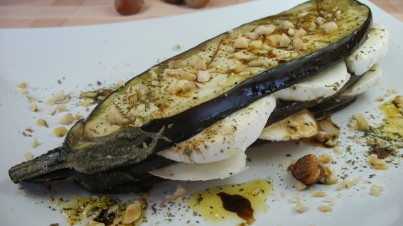The eggplant is a wonderful fruit that is part of the family solanaceae, and is related to tomatoes, capsicums and even potatoes. Although classified a fruit, it's used as a vegetable and is available in many colours, shapes and types. It many other cultures around the globe, it may be known as an aubergine, bringal, egg fruit or melongene.
When you think of eggplants, you may start to imagine Greek or other Mediterranean cuisine, grilled and roasted with olive oil and is the main ingredient in mousakka and baba ganoush. It's also a very well used Asian and African ingredient, although the types used are often quite different.
The use of eggplant in cooking is not only to provide texture and flavour, but known and used to absorb the flavours they're prepared in. It's often considered that eggplants have some bitterness, but modern varieties tend to be less so. A common practice is to sprinkle cut eggplant with salt to absorb some of the moisture
How to prepare
Is always a good idea to give the fruit a wash over and pat dry. Trim off the green stem attachment (known as a calyx) then the eggplant can be prepared as desired - cut into rounds (thick or thin), into small or large cube chunks, in half for stuffing or left whole for roasting. It's best to leave the skin on, as it helps to hold the flesh together during cooking but is also a key source of nutrients. The flesh when cut open should be a creamy white, quite firm and will contain no pulp or juice (like tomatoes). The flesh is likely to brown soon after cutting, so ideally prepare just before using, or sprinkle over with some lemon juice.
It is likely there will be some seeds in the lower portion of the fruit which don't require removal, they're quite edible. Larger fruit will tend to have more seeds, so best to use two medium sized fruit than one large one.
Their use is endless and can be added and prepared in almost anyway you can think of. Similar to capsicums, they are often initially fire roasted whole to impart a smokiness into the flesh.
Eggplants have a short preparation time and is advised not to consume them raw.
- Baked: 8-10 minutes
- Microwave: 5-7 minutes
- Grilled: 4-5 minutes
- Stir-fried: 3-5 minutes
- Roasted: 10-12 minutes
- Added to a stew: 10-15 minutes
Buyer's and storage guide
When buying an eggplant, it should be firm, uniform in its colouring, a fresh green stem attachment and have a smooth feel to the skin.
It's best to not store eggplants in the refrigerator, as this can effect their colour externally and internally. Buy fresh to use as needed and store somewhere cool in the kitchen. Ripening will continue and fruit are over mature when the skin colour dulls and the flesh is soft.
Serving
- Stir-fry eggplant slices in white wine with garlic, thyme and parsley and serve with cooked onions, capsicums and fresh herbs
- Eggplant can be substituted for meat in many dishes, simply cut into slices or cubes and add to stews and curries or make a classic eggplant mousakka
- Cut in half, hollow out part of the flesh and stuff with a combination of rice with minced meat or lentils, bake and serve with a fresh tomato sauce
- Slice lengthways, brush with olive oil and grill or roast in the oven, or on the BBQ, allow to cool and use for antipasto, pizza topping or simply chopped and tossed through salads or create an eggplant stack with slices of fresh tomato and mozzarella topped with fresh basil
- Roast eggplants whole in the oven, allow to cool and scoop out the flesh to make wonderful eggplant dips with olive oil, garlic, lemon, tahini and serve with crispy bread Make eggplant parmigiana by coating thin slices with breadcrumbs and lightly pan frying and serve with a fresh garden salad



